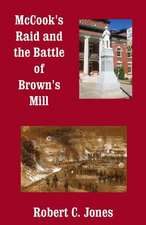The Supreme Court
Autor William H. Rehnquisten Limba Engleză Paperback – 31 ian 2002
The public often hears little about the Supreme Court until decisions are handed down. Here, Rehnquist reveals its inner workings--the process by which cases are chosen, the nature of the conferences where decisions are made, and the type of debates that take place. With grace and wit, this incisive history gives a dynamic and informative account of the most powerful court in the nation and how it has shaped the direction America has taken.
Preț: 125.32 lei
Nou
Puncte Express: 188
Preț estimativ în valută:
23.98€ • 25.10$ • 19.96£
23.98€ • 25.10$ • 19.96£
Carte disponibilă
Livrare economică 10-24 martie
Preluare comenzi: 021 569.72.76
Specificații
ISBN-13: 9780375708619
ISBN-10: 0375708618
Pagini: 336
Dimensiuni: 131 x 206 x 18 mm
Greutate: 0.31 kg
Ediția:Vintage Books.
Editura: Vintage Publishing
ISBN-10: 0375708618
Pagini: 336
Dimensiuni: 131 x 206 x 18 mm
Greutate: 0.31 kg
Ediția:Vintage Books.
Editura: Vintage Publishing
Notă biografică
William H. Rehnquist is the sixteenth Chief Justice of the United States Supreme Court.
Extras
Chapter 1
Marbury v. Madison
One need understand only a few of its cases to understand the Supreme Court's role in our nation's history. But one must assuredly understand the case of Marbury v. Madison. This case established the authority of the federal courts to declare a law passed by Congress unconstitutional and therefore void. The vitally important legal principle of the case can be condensed into a sentence or two, and the justification for the doctrine espoused by Chief Justice John Marshall in his opinion for the Court can be comprehended in a page or two. But like so many abstractions standing alone, these tend to go in one ear and out the other when people have no regular need to repair to such doctrine. I think that a fuller understanding of the doctrine itself may be gained by a knowledge not only of the facts of the case but also of the historical setting.
Those who have seen the city of Washington in the early part of the twenty-first century, firmly ensconced as a metropolis of four million at the southern end of the eastern "urban corridor" of the United States, may have difficulty envisioning the city as it existed in 1803, the year the Supreme Court decided the case of Marbury v. Madison. The Constitution adopted by the Philadelphia Convention in 1787 had provided for the creation of a "district" not exceeding ten miles square to become "the seat of the Government of the United States," but it had left the location of that district to Congress. Congress decided that the site of the government should be moved from New York to Philadelphia in December 1790, and ten years later that it should be moved again to the District of Columbia, a ten-mile-square territory on both sides of the Potomac River. Maryland ceded the necessary territory on the north side of the river, including the city of Georgetown, and Virginia the necessary territory on the south side of the river, including the city of Alexandria.
It is easy today to think of Washington at the opening of the nineteenth century as a somewhat smaller version of the Philadelphia and New York of that time. But nothing could be further from the truth. There were, as just noted, two honest-to-goodness cities already in the District-Georgetown in the northwestern part with a population of about three thousand, and Alexandria in the southern part with a population of about five thousand. But the major part of the District of Columbia designated to be the federal city, and named after George Washington, was still largely a wilderness. The census of 1800 gave it a population of just over three thousand. Philadelphia at this time had existed for more than a century, and had a population of more than forty thousand; New York had existed for a century and a half, and had a population of nearly eighty thousand.
The various departments of government began moving to Washington from Philadelphia during the year 1800, and John Adams was the first president to occupy the newly built President's House, as it was then called. His wife, Abigail, arriving there for the first time in November 1800, observed:
I arrived about 1 o'clock at this place known by the name of the city, and the Name is all that you can call so. As I expected to find it a new country, with Houses scattered over a space of 10 miles, and trees and stumps and plenty with a castle of a house-so I found it-The President's House is in a beautiful situation in front of which is the Potomac with a view of Alexandria. The country around is romantic but wild, a wilderness at present. [Junior League of Washington, p. 81]
Albert Gallatin, designated by Thomas Jefferson to be secretary of the treasury as soon as Jefferson assumed the presidency in March 1801, said upon his arrival in the city to take up the duties of his office:
Our local situation is far from being pleasant or even convenient. Around the Capitol are 7 or 8 boarding houses, 1 tailor, 1 shoemaker, 1 printer, a washing woman, a grocery shop, a pamphlet and stationery shop, a small dry goods shop and an oyster house. This makes the whole of the federal city as connected with the Capitol. [Junior League, p. 87]
A contemporary traveler observed that "the entrances or avenues, as they are pompously called, which lead to the Am. seat of Gov't, are the worst roads I passed in the country. . . . Deep ruts, rocks, and stumps of trees every minute impede yr. progress and threaten yr. limbs with dislocation" (Junior League, p. 82).
Jenkins Hill, a prominent elevation roughly in the center of the District, had been chosen as the site for the Capitol building, but by the time of Jefferson's first inauguration, only the north, or Senate, wing had been completed. The south wing was a temporary brick structure known as the "oven" and occupied by the House of Representatives. A list of Washington buildings drawn up in November 1801 showed a total of 621 houses standing on private land.
On March 4, 1801, Jefferson simply walked from his nearby boardinghouse to the Senate chamber inside the Capitol building to take his oath from John Marshall, his distant cousin and the newly appointed Chief Justice of the United States. Marshall, who throughout his thirty-four years as Chief Justice lived with his colleagues in a boardinghouse near the Capitol during the time they were in Washington, probably walked from his own boardinghouse to administer the oath to Jefferson.
Just as it is difficult to imagine the Washington of 1801 on the basis of the Washington that exists today, it is also difficult to
envision the way in which the Supreme Court was housed in 1801 on the basis of the "marble temple" in which it is housed today. Surely many of those who have seen the beautiful Supreme Court building located opposite the east plaza of the Capitol must have felt it was entirely fitting that each of the three independent branches of the federal government should be symbolized by a building-the president by the White House, the Congress by the Capitol, and the Supreme Court by its building.
But such was not the case in 1801. It was not until January 20, 1801, that any notice was taken of the need to provide the Supreme Court with a place to conduct its term, which would begin the next month. At this time the District Commissioners recommended to Congress that, "As no house has been provided for the Judiciary of the United States, we hope the Supreme Court may be accommodated with a room in the Capitol to hold its sessions until further provisions shall be made, an arrangement, however, which we would not presume to make without the approbation of Congress." Congress responded to this suggestion by designating a committee room on the first floor of the Capitol building as a "courtroom," and there the Court sat for seven years until more spacious quarters were afforded it. In the words of a leading student of the Court:
In this small and undignified chamber, only 24 feet wide, 30 feet long and 21 feet high, and rounded at the south end, the Chief Justice of the United States and his associates sat for eight years. [Warren, Vol. I, p. 171]
And what of the Chief Justice and his five associate justices?
John Marshall, universally referred to as "the great Chief Justice," was born in Fauquier County, Virginia, in 1755. He had commanded a line company in the Revolutionary War and had fought in the battles of Brandywine, Germantown, and Monmouth before he was twenty-five years of age. He served under George Washington at Valley Forge, from whom he acquired "a strong sense of nationalism and respect for discipline and authority" (Haskins and Johnson, p. 102). After independence was achieved, Marshall served first in the Virginia legislature and then in Congress. He was appointed one of the famous "XYZ" commissioners sent to deal with Talleyrand and the French Directory in 1798, and upon his return he served as secretary of state to John Adams in the closing days of the latter's administration.
At that time a vacancy occurred in the chief justiceship by reason of the resignation of the incumbent, Oliver Ellsworth, in December 1800. By then it already appeared that the election of 1800 had gone against the Federalists, and John Adams felt a strong need to put a dedicated Federalist on the bench before the government should come into the hands of Jefferson and the Republicans. He offered the position to John Jay, who had earlier occupied it before resigning to run for governor of New York; but Jay declined in early January. Adams then passed over two Associate Justices of the Court, William Cushing and William Paterson, whom he was thought to be considering, and, "like a bolt out of the blue," nominated John Marshall.
From the portraits of John Marshall in existence today, it seems to me that the most striking characteristic of the man is his piercing dark eyes. He looks like a man who has a good sense of humor and is mentally keen. In physical appearance he was tall, loose-jointed, and often negligently dressed. William Wirt wrote, "In his whole appearance, and demeanor; dress, attitudes, gestures; sitting, standing or walking; he is as far removed from the idolized graces of Lord Chesterfield, as any other gentleman on earth" (W. Wirt, The Letters of the British Spy [Baltimore, 1811], p. 95).
His longtime colleague on the Court, Joseph Story, said of him: "I love his laugh-it is too hearty for an intriguer; and his good temper and unwearied patience are equally agreeable on the bench and in the study" (Junior League 1977, 101). Andrew Oliver, in his interesting work The Portraits of John Marshall, makes this observation:
[T]here is a remarkable consistency in the several types of his portraits, the only difference being due, undoubtedly, not so much to Marshall's change in appearance as he grew older but rather to the eye of the artist. . . . There is no difficulty in discovering in Inman's aged Chief Justice the young and handsome envoy to France as he appeared in 1797. Jefferson and the two Adamses grew old, old and tired, tired and wearied looking. Marshall, aged 80, in the face of the dreaded operation for the stone only a day or two later, looks down on us from Inman's canvas as serene, as gentle, and yet as firm,
as he appeared before his elevation to the Court 30 years before. And as he looked while on the bench throughout his career as Chief Justice. [Oliver, 1977]
The Court's senior associate justice, William Cushing, was a native of Massachusetts, appointed to the Court by George Washington in 1789. He was a solid, competent lawyer, although by 1801 he was apparently showing some of the infirmities of age. William Paterson, appointed by Washington in 1793, was a distinguished New Jersey lawyer and an important figure in the Constitutional Convention in Philadelphia. A majority of the Senate that confirmed Marshall as
Chief Justice would have apparently much preferred to see President Adams nominate Paterson to that position.
Samuel Chase of Maryland, known as "Old Bacon Face" because of his brownish-red complexion, was an able lawyer, strong-minded and clear-thinking. But he was also "a man of violent opinions, overbearing manners, and fierce temper, he made enemies rapidly and easily, and he was always a center of controversy, in law as in politics" (Haskins and Johnson 1981, 91). The commencement of the Supreme Court's term, scheduled to begin in August 1800, had to be delayed partly because Justice Chase was speaking to political gatherings in Maryland on behalf of John Adams's candidacy for the
presidency (Warren 1923, I: 156).
Bushrod Washington of Virginia had been appointed to the Court by John Adams in 1798. He was the nephew of George Washington, and was destined to serve thirty-one years as an associate justice on the Court. He was regarded by his contemporaries as an accomplished lawyer, but seems to have been primarily a legal craftsman rather than anything like a broad-gauged statesman. He was short in stature, boyish in appearance, and apparently, like Marshall, a careless dresser.
The most junior justice of the Court in 1801 was Alfred Moore, who had been appointed by President Adams two years earlier. Since he was destined to serve only five years on the Court, we know very little about him. He was a North Carolinian, well thought of at the bar of that state. He apparently looked much like a child, being only four and a half feet tall, and weighing between eighty and ninety pounds.
These, then, were the six men who comprised the Supreme Court of the United States when the case of Marbury v. Madison began before them in December 1801.
William Marbury was one of the so-called "midnight judges," appointed justice of the peace in the District of Columbia by John Adams on the eve of his surrendering the presidency to Thomas Jefferson. But while Marbury had been duly nominated by the President and confirmed by the Senate, because of a last-minute mix-up occasioned by the change of
administration on March 4, 1801, his commission executed by the President had never been delivered to him by the secretary of state. Jefferson, upon assuming office, issued commissions to a majority of the some forty justices of the peace in Marbury's position but declined to issue Marbury's. Marbury requested that James Madison, newly appointed as Jefferson's secretary of state, deliver to him his commission, but Madison declined. Marbury then sought a writ of mandamus (Latin for "we command") from the Supreme Court of the United States, which would direct Madison to deliver to him his commission. The proceedings were begun in December 1801; the Court heard final arguments in the case in February 1803 and handed down its opinion later that same month.
During the stormy presidency of John Adams, from 1797 to 1801, bitter divisions in public opinion between the Federalists and the anti-Federalists, or Republicans, had manifested themselves, divisions that were to affect history for a number of years. In 1798 Congress enacted the so-called Alien and Sedition Acts, consisting of four different laws. The first three dealt with aliens: They raised the waiting period for naturalization from five to fourteen years, permitted the detention of subjects of an enemy nation, and authorized the president to expel any alien considered by him to be dangerous. The fourth law was the Sedition Act, which outlawed the publishing of "false" or "malicious" writings against the government and the inciting of opposition to any act of Congress or of the president.
Marbury v. Madison
One need understand only a few of its cases to understand the Supreme Court's role in our nation's history. But one must assuredly understand the case of Marbury v. Madison. This case established the authority of the federal courts to declare a law passed by Congress unconstitutional and therefore void. The vitally important legal principle of the case can be condensed into a sentence or two, and the justification for the doctrine espoused by Chief Justice John Marshall in his opinion for the Court can be comprehended in a page or two. But like so many abstractions standing alone, these tend to go in one ear and out the other when people have no regular need to repair to such doctrine. I think that a fuller understanding of the doctrine itself may be gained by a knowledge not only of the facts of the case but also of the historical setting.
Those who have seen the city of Washington in the early part of the twenty-first century, firmly ensconced as a metropolis of four million at the southern end of the eastern "urban corridor" of the United States, may have difficulty envisioning the city as it existed in 1803, the year the Supreme Court decided the case of Marbury v. Madison. The Constitution adopted by the Philadelphia Convention in 1787 had provided for the creation of a "district" not exceeding ten miles square to become "the seat of the Government of the United States," but it had left the location of that district to Congress. Congress decided that the site of the government should be moved from New York to Philadelphia in December 1790, and ten years later that it should be moved again to the District of Columbia, a ten-mile-square territory on both sides of the Potomac River. Maryland ceded the necessary territory on the north side of the river, including the city of Georgetown, and Virginia the necessary territory on the south side of the river, including the city of Alexandria.
It is easy today to think of Washington at the opening of the nineteenth century as a somewhat smaller version of the Philadelphia and New York of that time. But nothing could be further from the truth. There were, as just noted, two honest-to-goodness cities already in the District-Georgetown in the northwestern part with a population of about three thousand, and Alexandria in the southern part with a population of about five thousand. But the major part of the District of Columbia designated to be the federal city, and named after George Washington, was still largely a wilderness. The census of 1800 gave it a population of just over three thousand. Philadelphia at this time had existed for more than a century, and had a population of more than forty thousand; New York had existed for a century and a half, and had a population of nearly eighty thousand.
The various departments of government began moving to Washington from Philadelphia during the year 1800, and John Adams was the first president to occupy the newly built President's House, as it was then called. His wife, Abigail, arriving there for the first time in November 1800, observed:
I arrived about 1 o'clock at this place known by the name of the city, and the Name is all that you can call so. As I expected to find it a new country, with Houses scattered over a space of 10 miles, and trees and stumps and plenty with a castle of a house-so I found it-The President's House is in a beautiful situation in front of which is the Potomac with a view of Alexandria. The country around is romantic but wild, a wilderness at present. [Junior League of Washington, p. 81]
Albert Gallatin, designated by Thomas Jefferson to be secretary of the treasury as soon as Jefferson assumed the presidency in March 1801, said upon his arrival in the city to take up the duties of his office:
Our local situation is far from being pleasant or even convenient. Around the Capitol are 7 or 8 boarding houses, 1 tailor, 1 shoemaker, 1 printer, a washing woman, a grocery shop, a pamphlet and stationery shop, a small dry goods shop and an oyster house. This makes the whole of the federal city as connected with the Capitol. [Junior League, p. 87]
A contemporary traveler observed that "the entrances or avenues, as they are pompously called, which lead to the Am. seat of Gov't, are the worst roads I passed in the country. . . . Deep ruts, rocks, and stumps of trees every minute impede yr. progress and threaten yr. limbs with dislocation" (Junior League, p. 82).
Jenkins Hill, a prominent elevation roughly in the center of the District, had been chosen as the site for the Capitol building, but by the time of Jefferson's first inauguration, only the north, or Senate, wing had been completed. The south wing was a temporary brick structure known as the "oven" and occupied by the House of Representatives. A list of Washington buildings drawn up in November 1801 showed a total of 621 houses standing on private land.
On March 4, 1801, Jefferson simply walked from his nearby boardinghouse to the Senate chamber inside the Capitol building to take his oath from John Marshall, his distant cousin and the newly appointed Chief Justice of the United States. Marshall, who throughout his thirty-four years as Chief Justice lived with his colleagues in a boardinghouse near the Capitol during the time they were in Washington, probably walked from his own boardinghouse to administer the oath to Jefferson.
Just as it is difficult to imagine the Washington of 1801 on the basis of the Washington that exists today, it is also difficult to
envision the way in which the Supreme Court was housed in 1801 on the basis of the "marble temple" in which it is housed today. Surely many of those who have seen the beautiful Supreme Court building located opposite the east plaza of the Capitol must have felt it was entirely fitting that each of the three independent branches of the federal government should be symbolized by a building-the president by the White House, the Congress by the Capitol, and the Supreme Court by its building.
But such was not the case in 1801. It was not until January 20, 1801, that any notice was taken of the need to provide the Supreme Court with a place to conduct its term, which would begin the next month. At this time the District Commissioners recommended to Congress that, "As no house has been provided for the Judiciary of the United States, we hope the Supreme Court may be accommodated with a room in the Capitol to hold its sessions until further provisions shall be made, an arrangement, however, which we would not presume to make without the approbation of Congress." Congress responded to this suggestion by designating a committee room on the first floor of the Capitol building as a "courtroom," and there the Court sat for seven years until more spacious quarters were afforded it. In the words of a leading student of the Court:
In this small and undignified chamber, only 24 feet wide, 30 feet long and 21 feet high, and rounded at the south end, the Chief Justice of the United States and his associates sat for eight years. [Warren, Vol. I, p. 171]
And what of the Chief Justice and his five associate justices?
John Marshall, universally referred to as "the great Chief Justice," was born in Fauquier County, Virginia, in 1755. He had commanded a line company in the Revolutionary War and had fought in the battles of Brandywine, Germantown, and Monmouth before he was twenty-five years of age. He served under George Washington at Valley Forge, from whom he acquired "a strong sense of nationalism and respect for discipline and authority" (Haskins and Johnson, p. 102). After independence was achieved, Marshall served first in the Virginia legislature and then in Congress. He was appointed one of the famous "XYZ" commissioners sent to deal with Talleyrand and the French Directory in 1798, and upon his return he served as secretary of state to John Adams in the closing days of the latter's administration.
At that time a vacancy occurred in the chief justiceship by reason of the resignation of the incumbent, Oliver Ellsworth, in December 1800. By then it already appeared that the election of 1800 had gone against the Federalists, and John Adams felt a strong need to put a dedicated Federalist on the bench before the government should come into the hands of Jefferson and the Republicans. He offered the position to John Jay, who had earlier occupied it before resigning to run for governor of New York; but Jay declined in early January. Adams then passed over two Associate Justices of the Court, William Cushing and William Paterson, whom he was thought to be considering, and, "like a bolt out of the blue," nominated John Marshall.
From the portraits of John Marshall in existence today, it seems to me that the most striking characteristic of the man is his piercing dark eyes. He looks like a man who has a good sense of humor and is mentally keen. In physical appearance he was tall, loose-jointed, and often negligently dressed. William Wirt wrote, "In his whole appearance, and demeanor; dress, attitudes, gestures; sitting, standing or walking; he is as far removed from the idolized graces of Lord Chesterfield, as any other gentleman on earth" (W. Wirt, The Letters of the British Spy [Baltimore, 1811], p. 95).
His longtime colleague on the Court, Joseph Story, said of him: "I love his laugh-it is too hearty for an intriguer; and his good temper and unwearied patience are equally agreeable on the bench and in the study" (Junior League 1977, 101). Andrew Oliver, in his interesting work The Portraits of John Marshall, makes this observation:
[T]here is a remarkable consistency in the several types of his portraits, the only difference being due, undoubtedly, not so much to Marshall's change in appearance as he grew older but rather to the eye of the artist. . . . There is no difficulty in discovering in Inman's aged Chief Justice the young and handsome envoy to France as he appeared in 1797. Jefferson and the two Adamses grew old, old and tired, tired and wearied looking. Marshall, aged 80, in the face of the dreaded operation for the stone only a day or two later, looks down on us from Inman's canvas as serene, as gentle, and yet as firm,
as he appeared before his elevation to the Court 30 years before. And as he looked while on the bench throughout his career as Chief Justice. [Oliver, 1977]
The Court's senior associate justice, William Cushing, was a native of Massachusetts, appointed to the Court by George Washington in 1789. He was a solid, competent lawyer, although by 1801 he was apparently showing some of the infirmities of age. William Paterson, appointed by Washington in 1793, was a distinguished New Jersey lawyer and an important figure in the Constitutional Convention in Philadelphia. A majority of the Senate that confirmed Marshall as
Chief Justice would have apparently much preferred to see President Adams nominate Paterson to that position.
Samuel Chase of Maryland, known as "Old Bacon Face" because of his brownish-red complexion, was an able lawyer, strong-minded and clear-thinking. But he was also "a man of violent opinions, overbearing manners, and fierce temper, he made enemies rapidly and easily, and he was always a center of controversy, in law as in politics" (Haskins and Johnson 1981, 91). The commencement of the Supreme Court's term, scheduled to begin in August 1800, had to be delayed partly because Justice Chase was speaking to political gatherings in Maryland on behalf of John Adams's candidacy for the
presidency (Warren 1923, I: 156).
Bushrod Washington of Virginia had been appointed to the Court by John Adams in 1798. He was the nephew of George Washington, and was destined to serve thirty-one years as an associate justice on the Court. He was regarded by his contemporaries as an accomplished lawyer, but seems to have been primarily a legal craftsman rather than anything like a broad-gauged statesman. He was short in stature, boyish in appearance, and apparently, like Marshall, a careless dresser.
The most junior justice of the Court in 1801 was Alfred Moore, who had been appointed by President Adams two years earlier. Since he was destined to serve only five years on the Court, we know very little about him. He was a North Carolinian, well thought of at the bar of that state. He apparently looked much like a child, being only four and a half feet tall, and weighing between eighty and ninety pounds.
These, then, were the six men who comprised the Supreme Court of the United States when the case of Marbury v. Madison began before them in December 1801.
William Marbury was one of the so-called "midnight judges," appointed justice of the peace in the District of Columbia by John Adams on the eve of his surrendering the presidency to Thomas Jefferson. But while Marbury had been duly nominated by the President and confirmed by the Senate, because of a last-minute mix-up occasioned by the change of
administration on March 4, 1801, his commission executed by the President had never been delivered to him by the secretary of state. Jefferson, upon assuming office, issued commissions to a majority of the some forty justices of the peace in Marbury's position but declined to issue Marbury's. Marbury requested that James Madison, newly appointed as Jefferson's secretary of state, deliver to him his commission, but Madison declined. Marbury then sought a writ of mandamus (Latin for "we command") from the Supreme Court of the United States, which would direct Madison to deliver to him his commission. The proceedings were begun in December 1801; the Court heard final arguments in the case in February 1803 and handed down its opinion later that same month.
During the stormy presidency of John Adams, from 1797 to 1801, bitter divisions in public opinion between the Federalists and the anti-Federalists, or Republicans, had manifested themselves, divisions that were to affect history for a number of years. In 1798 Congress enacted the so-called Alien and Sedition Acts, consisting of four different laws. The first three dealt with aliens: They raised the waiting period for naturalization from five to fourteen years, permitted the detention of subjects of an enemy nation, and authorized the president to expel any alien considered by him to be dangerous. The fourth law was the Sedition Act, which outlawed the publishing of "false" or "malicious" writings against the government and the inciting of opposition to any act of Congress or of the president.
Recenzii
"Rehnquist is a clear and engaging historian. . . . The Supreme Court hits the high points."–The Washington Post
“This book, written for laymen in a clear and decidedly nontechnical manner, is of interest to anyone who cares about the Supreme Court.”–The American Statesman (Austin)
“This book, written for laymen in a clear and decidedly nontechnical manner, is of interest to anyone who cares about the Supreme Court.”–The American Statesman (Austin)

















